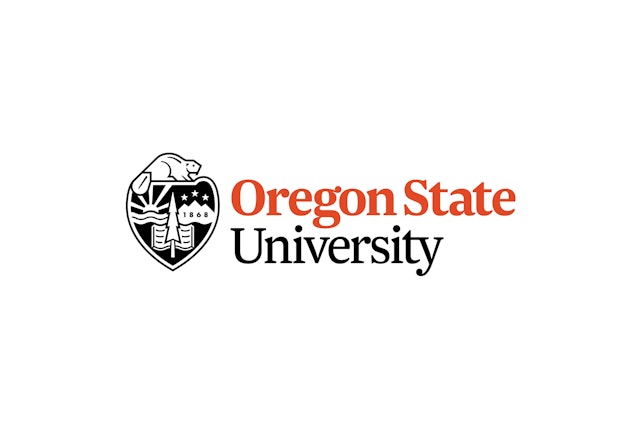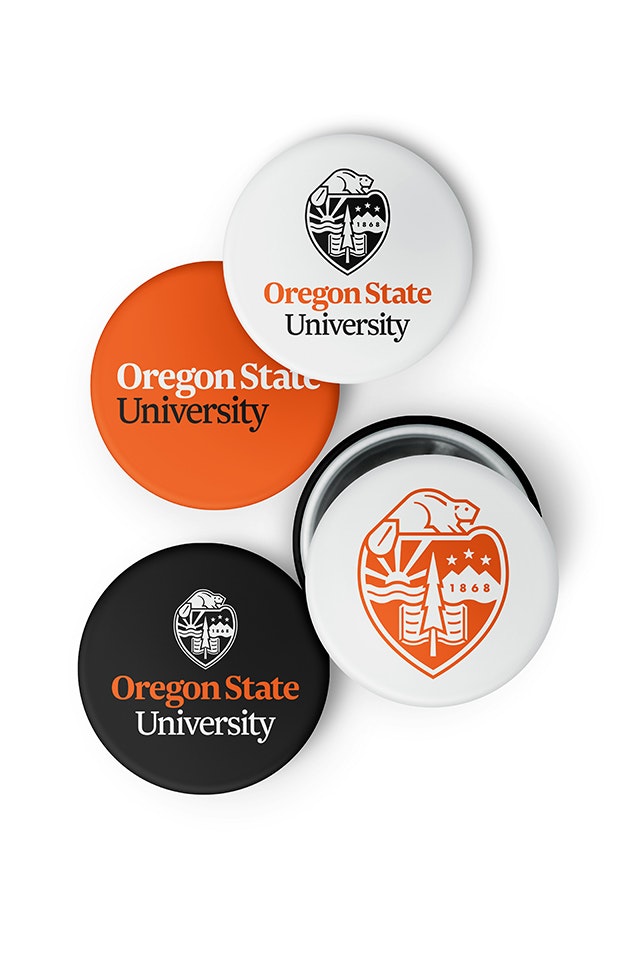

The addition of Oregon State’s beaver mascot to the academic shield personalizes the mark and distinguishes the university’s identity from the state seal.










They proudly refer to themselves as “Beaver Nation,” so on the occasion of Oregon State University’s 150th Anniversary, Pentagram has given the institution back its beloved beaver. Now the academic side of the university has their own version of the school’s beaver mascot that can co-exist with the football team’s logo designed by Nike in 2013.
Earlier this week Oregon State, based in Corvallis, unveiled Pentagram’s redesign of the university’s institutional logo featuring a new academic crest and word mark set in the contemporary Roman typeface Newzald. The Pentagram team chose the typeface, designed by the Klim Type Foundry based in New Zealand, because it struck the right balance between academic gravitas and the rugged ethos and outdoorsy courses offered by the university. The completely revamped identity system replaces the school’s previous academic identity–the letters “OSU” set in a condensed san-serif face, which was adopted in 2003.
Early in the research phase the design team came to the realization that there are nearly a hundred universities and colleges in the U.S. with names that begin with the letter “O” (particularly Oregon State’s cross-state rival, the University of Oregon, that uses a large-cap letter “O” as their primary identity) and at least two well-known, national institutions–Ohio State University and Oklahoma State University, that use the initials “OSU” prominently as their identities. Given this information, the design team decided to move away from the acronym altogether during its explorations for a new, more effective identity direction for Oregon State University.
Oregon was the 33rd state to join the union in 1859, relatively late in the game, and less than ten years later the newly ratified state founded Oregon State University in Corvallis. At the time, Oregon’s fledgling institution of higher learning, the state’s vaunted Land Grant University, took the crest of Oregon as its own identity.
The official-looking crest, consisting of a plumpish heart-shaped shield is bursting at the seams with the kind of illustrated historical symbols and metaphors that were typical for state seals and other forms of institutional heraldry at that time. A covered wagon, symbolizing the hardy pioneers who first came to Oregon, is forging its way across the middle of the composition and the image of a haystack with plow, representing the state’s rich agricultural heritage, is positioned toward the bottom. The lush evergreen forests of the Pacific Northwest are depicted in the upper right-hand corner of the shield with a stand of Douglas Firs, Oregon’s state tree, and a hint of a mountain off in the distance. The scene in the upper left-hand corner of the crest depicts a British Man O’ War hightailing it out of the scenic waters of the Oregon coast with a technically superior American war vessel in hot pursuit. On the horizon there’s a sun setting in the western sky and an arc of stars cascades down both sides of the outer-edges of the shield.
The only wildlife depicted in the composition are a lone elk standing at the edge of the forest, and a large eagle with its wings outstretched, symbolizing the United States, perched on top of the shield. The beaver, Oregon’s state animal, is nowhere to be found in the crest but a beaver does make an appearance on the state’s flag–if only on one side. The Oregon State flag is an unusual design in that it is the only state flag in the union with two different sides. One side of the flag is dominated by Oregon’s fussy crest, and the other side features a primitive, but charming, rendering of a beaver standing on a small, oddly shaped log.
The state flag and the fact that OSU had co-opted Oregon’s official identity featured on one side of the flag, and had taken the beaver featured on the other side, as its school mascot lead the Pentagram team down the road of exploring a simpler rendition of the crest for the university’s identity. A new heraldic shield that could hold up in today’s demanding, small-usage situations–like online and mobile phone applications.
The resulting academic crest, created in the spirit of the longstanding tradition of using heraldry as identity for institutions of higher learning, references the complex, dated-looking state crest but simplifies its symbolism to represent Oregon State’s four major grants: Land, Sea, Sun and Space. A lone Douglas fir, the state tree and an Oregon icon featured on the state’s license plates, towers up through the center of the new shield. The tree, a traditional metaphor for knowledge, represents Oregon State’s specialization in the area of forestry. A large book, another traditional symbol for knowledge, straddles the tree and represents the university’s commitment to academic excellence. On the right side of the composition, three stars representing Oregon State’s space grant and its three main campuses, rise in the sky above three peaks representing the Three Sisters mountains located near Bend where the university’s sister institution, Oregon State Cascades, is based. The date of the university’s founding, 1896, is emblazoned across the face of the mountain range.
The distinctive heart-shaped shield, the “Heart of Oregon,” was redrawn to be less fat and squat and the eagle perched on top of the original crest was replaced with a simpler, more refined interpretation of the awkwardly drawn, state flag beaver. The addition of Oregon State’s beaver mascot to the academic shield personalizes the mark and distinguishes the university’s identity from the state seal.
Office
- Austin
